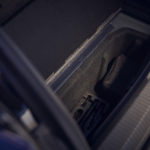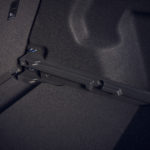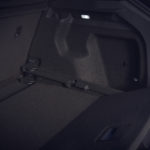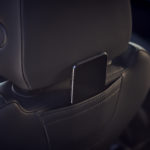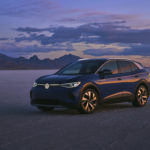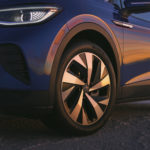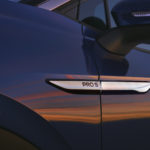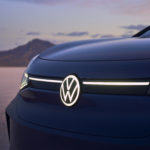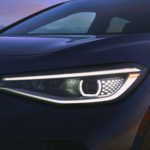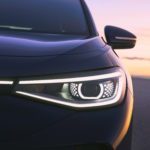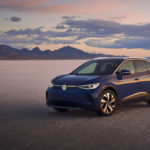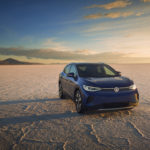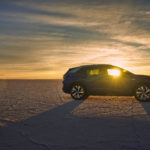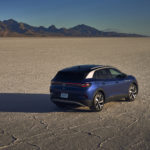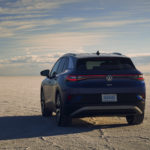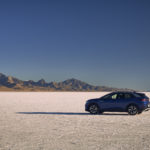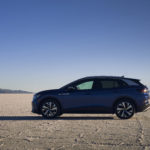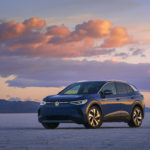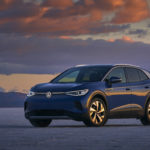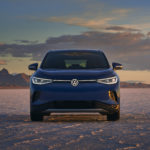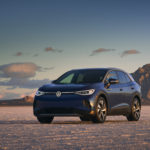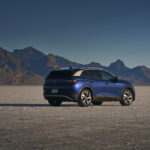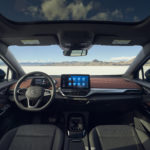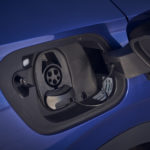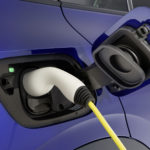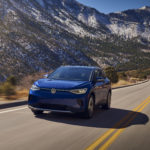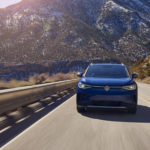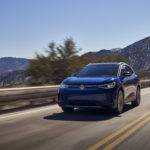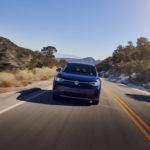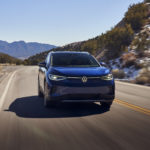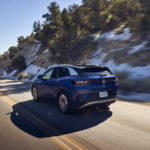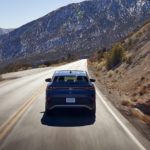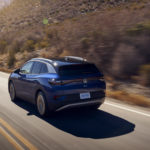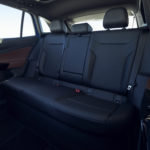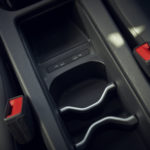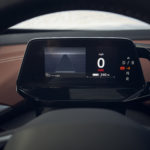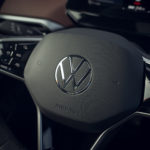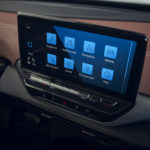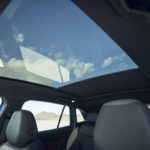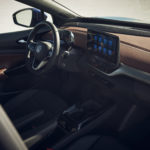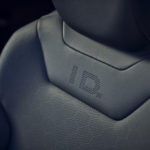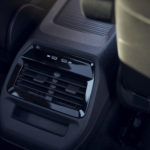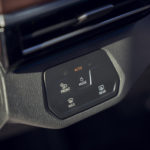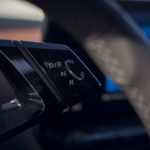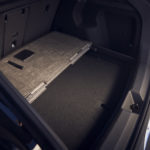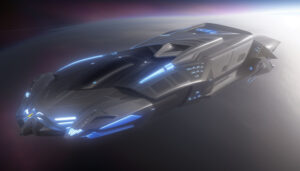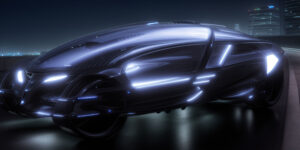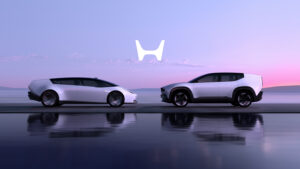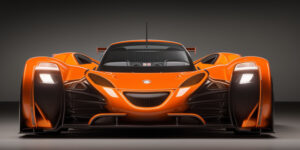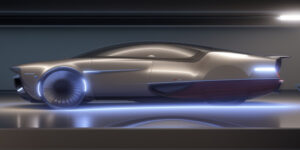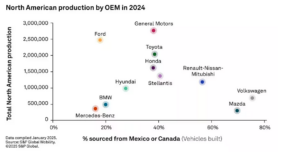2021 Volkswagen ID.4 Electric SUV
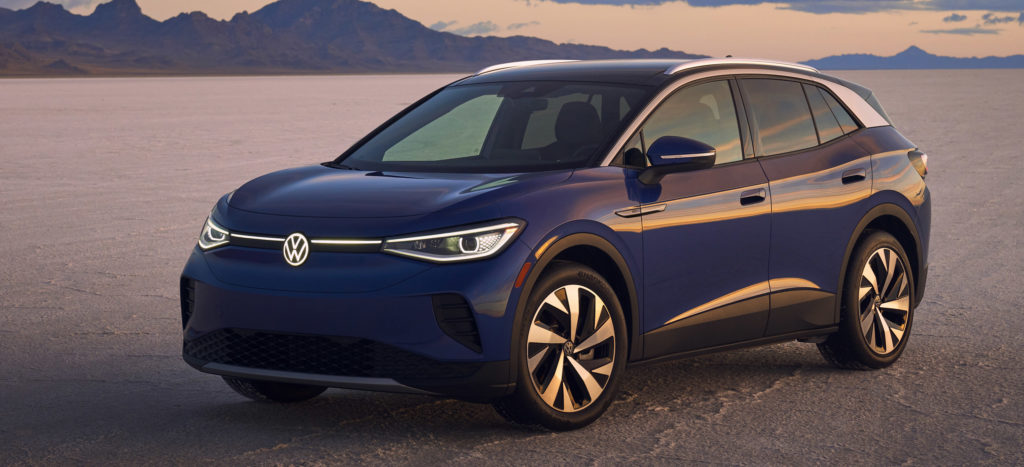
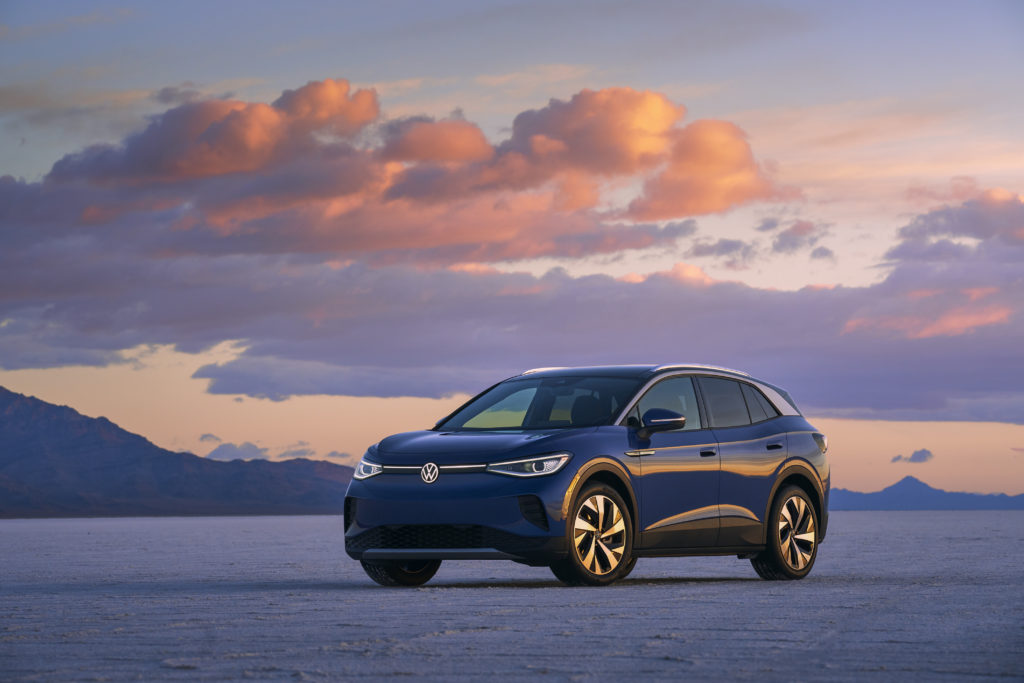
The ID.4 is Volkswagen’s first all-electric SUV and the brand’s first global EV. Built on Volkswagen’s MEB electric vehicle architecture—the modular electric drive matrix—it marries the strengths of a purpose-built EV with performance, packaging and value, features that have marked the brand for decades. The ID.4 competes in the world’s largest market segment—compact SUVs—and is currently produced in Germany and China; in the future, it will also be assembled in the United States.
At launch in the U.S., the 2021 ID.4 offers an 82kWh (gross) battery and a rear-mounted AC permanent-magnet synchronous motor with 201 horsepower and 229 pound-feet of torque. The EPA-certified range for the Pro S (Statement) and 1st Edition models is 250 miles.
The ID.4 offer structure is simple—four trims and one package. The entry-level Pro model is well equipped, with features typically found on higher trims baked in for added value. Pricing starts at $39,995 MSRP, before a potential Federal tax credit of up to $7,500. For highly qualified customers through Volkswagen Credit, the monthly lease payment for a 36-month lease (with 10,000 miles a year) is $379 per month with $3,579 due at signing, excluding tax, title, license, options and dealer fees. Starting later in 2021, the ID.4 AWD Pro will be available with an MSRP of $43,675.
Pro S models are priced from $44,495, and add standout styling elements, along with creature comfort and convenience features. A Gradient Package is available for $1,500, and includes larger wheels and further design differentiators. AWD Pro S models will be priced from $48,175 on arrival later this year.
A special ID.4 1st Edition model was available at launch, and has since sold out. Priced at $43,995, this rear-wheel-drive model combined Pro S and Gradient features with a handful of unique design elements.
Destination for all ID.4 models is $1,195.
Powertrain
With the MEB architecture, Volkswagen is returning to its roots—the electric motor is located at the rear, just like the original Beetle. The motor is located above the rear axle, just in front of the centerline of the wheels, and transfers its torque to a two-stage 1-speed gearbox. It is ideally placed for agile handling and traction, and nearly silent. In fact, it’s so quiet that a synthetic sound is generated up to speeds of about 20 mph to aid pedestrian and cyclist awareness.
The AC permanent-magnet synchronous motor puts out 201 horsepower and 229 pound-feet of torque that is available instantly. A powerful, all-wheel-drive variant with a second electric motor will follow later in 2021.
One of the main strengths of the permanent magnet synchronous motor is its efficiency—well above 90 percent in almost all driving situations. During the manufacturing process, Volkswagen uses a complex piece of technology known as a hairpin winding: the stator’s coils are made from square copper wires, which after bending, are visually similar to hairpins. This hairpin winding technique enables the wires to be packed more tightly. As result, there is more copper in the stator—power and torque are increased, while cooling is more efficient. The electric drive unit only weighs about 200 pounds, including the motor, gearbox and power and control electronics for the electric drive, and fits into a duffle bag. The electric drive, the battery system and other essential components of the ID.4 are produced by the Volkswagen Group Components sites in Kassel, Braunschweig and Salzgitter, Germany.
At launch, the vehicle will be offered with an 82kWh (gross) battery pack with an EPA-estimated 250 miles of range on a single charge for the Pro S and 1st Edition models. The EPA-estimated fuel economy for the Pro S and 1st Edition models is 104 MPGe for city driving; highway driving is rated at 89 MPGe, and combined city/highway at 97 MPGe.
The ID.4 can provide as much as $3,500 in estimated fuel cost savings over five years compared to the average gas vehicle.
The battery is comprised of 288 pouch cells in 12 modules. It is positioned in the underbody to create a low center of gravity for optimal driving dynamics as well as extremely well-balanced weight distribution and weighs 1,087 pounds.
Around a fifth of the battery’s weight is accounted for by the housing. This is a scalable aluminum construction whose interior framework is made from extruded and pressure-cast profiles. The housing is bolted to the frame, helping to improve bodyshell rigidity. A strong all-round frame made of extruded aluminum sections protects the battery system against damage in the event of an accident, and the battery is also disabled if the vehicle is involved in a serious accident. A replaceable aluminum underbody panel protects the battery against the road.
The temperature of the battery modules is controlled using a floor plate with built-in water channels. The thermal management system keeps the battery in the ideal temperature range of around 77 degrees Fahrenheit at all times, benefiting power output, fast DC charging, and the battery service life. The High-Voltage System Limited Warranty provides that the battery will still have at least 70 percent of its original capacity after eight years of operation or 100,000 miles, whichever occurs first.
The ID.4 can be charged with both alternating current (AC) and direct current (DC) fast-charging capability. All ID.4 models are equipped with a CCS (Combined Charging System) socket, which allows for both home and public charging. The 11 kW onboard charger allows the ID.4 to charge to full in as little as seven and a half hours at a home or public Level 2 charger.
At a public DC fast-charging station, with 125 kW charging, the ID.4 can go from five to 80 percent charged in about 38 minutes. The 2021 ID.4 comes with three years of unlimited charging at Electrify America DC fast chargers at no additional cost, helping to inspire range confidence. Volkswagen customers will be able to manage their charging plan through the Electrify America app.
Electrify America is the nation’s largest open DC fast charging network with more than 555 charging stations and more than 2,400 DC fast chargers, including two cross-country routes to take electric vehicle drivers from Washington D.C. to L.A and Jacksonville to San Diego. To meet current and future demand, Electrify America continues to expand rapidly, with plans to install or have under development approximately 800 total charging stations with about 3,500 DC fast chargers by December 2021.
Chassis
The ID.4 is designed to be fun to drive: the rear-wheel-drive layout helps ensure strong traction, and with the large high-voltage battery located between the axles, lowering the center of gravity, the weight distribution is very close to 50:50. With 3.5 turns lock-to-lock and a stellar curb-to-curb turning radius of 33.5 feet, the ID.4 feels nimble, especially compared with other compact SUVs.
The ID.4 has a strut-type front suspension, with lower control arms, coil springs, telescopic dampers and an anti-roll bar. For the first time at Volkswagen, the steering rack is located in front of the centerline of the wheels, to maximize stability during cornering. At the rear, the car has a compact multi-link suspension that features coil springs, telescopic dampers and an anti-roll bar. While the chassis and body are made from steel, parts of the suspension are made of aluminum to reduce weight.
The ID.4 features Driving Mode Selection, which gives the driver a choice of four modes. Eco, Comfort and Sport are preconfigured. In Custom mode, the driver is given additional settings on the central display: They can select between Comfort and Sport for various driving features—in other words, even more comfortable or even more dynamic driving.
The new Vehicle Dynamics Manager control system, which debuted last year on the European Mk 8 Golf GTI, is standard on ID.4 models. This system, which works closely with the ESC stability control system, controls the wheel-selective brake interventions of the XDS® electronic transverse differential lock. It uses a digital target model to achieve optimum driving and steering behavior. As soon as the vehicle turns into a corner, the ID.4 behaves in a spontaneous, linear and accurate manner.
The ESC in turn cooperates closely with the control units for the electric motor and the power electronics. Although a rear-wheel-drive car tends to oversteer in extreme circumstances, this networking is designed to ensure that the rear wheels of the ID.4 find grip in different situations—during acceleration, when cornering, and when the brake regeneration takes place. This type of traction control is speed based and is another innovation from Volkswagen. It takes place automatically every millisecond, and is so fast and non-intrusive that the driver hardly feels any intervention.
The Pro and Pro S models are outfitted with large 19-inch aluminum-alloy wheels. Pro S models when outfitted with the Gradient package upgrade to 20-inch wheels, and are standard on 1st Edition models. The wheels are aerodynamically optimized by their flat design, and the tires are optimized for low rolling resistance.
A combination of brake types is used on ID.4. It features disc brakes on the front wheels and drums at the rear—the difference being specific to electric vehicle needs. As EVs rely on regenerative braking, disc brakes on the rear can be less effective than drums after long periods of not being put to heavy use. The discs on the front of the ID.4 models are 13.4 inches in diameter on rear-wheel-drive models and 14.1 inches on AWD models.
The regenerative braking system in the ID.4 is designed for efficiency and offers the driver two modes. The D (Drive) position is the default mode, automatically activated upon start-up. In this position, the car can coast whenever the driver’s foot is off the accelerator or brake pedal. As soon as the driver applies the brakes, energy recuperation is activated, and the electric drive motor feeds power back into the battery.
During the majority of everyday braking maneuvers—up to around 0.25 g of deceleration—the electric drive motor performs the braking alone, while the electric brake servo only activates the friction brakes in situations that demand more stopping power. The transition from generator-based to hydraulic braking goes almost unnoticed, thanks to highly accurate and swift brake and drive system control. These systems also make sure that the rear wheels, where brake energy recuperation takes place, always have a sufficient amount of grip.
Each ID.4 features predictive Eco Assistance as standard. It analyzes data from the navigation system and vehicle sensors to provide drivers with effective support in driving efficiently and in a relaxed way. Once the ID.4 approaches a low-speed area, such as towns and cities, junctions and bends, Eco Assistance notifies drivers to take their foot off the accelerator pedal. From this moment on, the system manages optimum coasting and energy recovery without drivers having to intervene. The car responds similarly when it approaches a vehicle ahead that is travelling at a lower speed.
The B (Brake) position enables the driver to select a heavier amount of regeneration. Drivers can use the gear selector rocker switch to change from the D position to B at any time. In this mode, the ID.4’s drive almost always recovers energy during lifting off, but not all the way to a standstill. The limit has been set at 0.13 g—enough for clearly noticeable deceleration that won’t confuse drivers of conventional internal combustion engine vehicles: intuitive operation is one of the vehicles’ greatest strengths.
Exterior
Like the architecture underneath, the exterior design of ID.4 represents a move towards the future, with a nod to the past. As on the Beetle, the Volkswagen logo is positioned centrally at the front because there is no radiator grille. The front end communicates strength with a sculpted front bumper that has large matte black intake-like scoops and diamond accents to give the car a powerful presence. Although these elements might seem decorative, these black plastic parts are actually functional for funneling air around the car, and the diamond shape is a common motif that is found in many areas of the ID.4.
Large LED headlights give the electric SUV a friendly but focused expression. An LED strip at the top of the headlight functions as the Daytime Running Lights (DRLs). Pro S and 1st Edition models add premium LED projector headlights with Volkswagen’s Adaptive Front-lighting System (AFS) and an illuminated light line stretching towards the center of the vehicle, creating a striking light signature. The headlights feature a diamond-pattern design on the housing, and are framed by illuminated rings that are flattened at the bottom. Pro S models also sport an illuminated Volkswagen logo.
From the front to the back, clean, flowing lines alternate with crisp edges for a refined yet futuristic look. The A-pillar starts a long way forwards, while a strong, wave-like shoulder line brings momentum into the vehicle body. Illuminated door handles lay flush and feature an electric release. The matte black cladding on the front end continues over the wheelarches and rocker panels, connecting to the rear bumper. The low greenhouse runs out into a strong C-pillar—a classic Volkswagen design feature—and into a long spoiler. At the rear, C-shaped LED taillight clusters are connected via a red light strip surrounding the Volkswagen logo, mirroring the front-end design. Diamond-pattern detailing runs through the clusters and across the back of the vehicle.
The ID.4 will available in six exterior colors—Glacier White Metallic, Mythos Black Metallic, Moonstone Grey, Scale Silver Metallic, Blue Dusk Metallic and King’s Red Metallic. All models come with a body color roof and black roof rails as standard. AWD models add a tow hitch and towing capacity of 2,700 lbs with a braked trailer, while Pro S models add a panoramic fixed-glass roof and power-folding side mirrors with diamond-pattern puddle lamp signature. Pro S models, when outfitted with the Gradient Package, and 1st Edition ID.4 models upgrade to a black roof and rear spoiler, while the C-pillars, roof line, roof rails, and accents shine in bright silver. The limited 1st Edition models also feature unique badging, black mirror caps, and a tow hitch with towing capacity of 2,200 lbs with a braked trailer; when painted in Glacier White Metallic, the matte black moldings are replaced with slate grey elements.
Aerodynamics and Packaging
The ID.4 is aerodynamically refined on the exterior to help it achieve an excellent drag coefficient of 0.28 on RWD models. The decisive factor is the flowing shape of the body with a greenhouse that is pulled sharply to the back. Multiple elements come into play to separate the flow at the rear: the large roof spoiler, the three-dimensional shape of the taillight clusters, and the diffuser that finishes the almost flat underbody at the rear. The flush door handles are also designed to optimize air flow for minimum drag losses, as are the wheels. The electrically-powered radiator blind in the front only opens when the power units need cooling air.
In the body, sophisticated solutions help to reduce the weight. The side sills, for example, are made from aluminum and ultra-high-strength steel, which is also good for crash performance.
The architecture of Volkswagen’s modular electric drive matrix (MEB) divides the space for people and technology in a unique way. Outside, the short overhangs and long wheelbase give it a dynamic presence, but they also help maximize space inside. A rear-mounted electric motor helps handling, and the rear axle location for the power and control electronics for the electric drivetrain frees up space inside the car. The under-hood area now accommodates just the radiator, 12-volt battery, wiper fluid and large components of the air conditioning system. Packaging the high-voltage battery as a flat block underneath the passenger compartment gives the car near-perfect weight distribution, but also means a flat floor for rear-seat passengers.
The ID.4 sits squarely in the middle of the compact SUV segment, size-wise. It is 4.6 inches shorter than the Volkswagen Tiguan, at 180.5 inches, with a 0.9-inch shorter wheelbase at 108.9 inches. It is 1.9 inches lower than Tiguan at 64.6 inches high, and 0.5 inches wider, at 72.9 inches for the rear-wheel drive model.
Passenger volume is similar to the Tiguan despite the overall smaller footprint, with 99.9 cubic feet total. Legroom is a comfortable 41.1 inches for front passengers and 37.6 inches in the rear seat. Cargo volume is 30.3 cubic feet behind the second row, and 64.2 cubic feet with the seats folded.
Interior
Volkswagen’s first fully-electric SUV features a modern, airy interior design with meticulous attention to detail. This begins right in front of the driver, with an innovative digital display replacing the traditional instrument cluster. The 5.3-inch ID.Cockpit is attached to the steering column, so that it’s always positioned ideally in the line of sight, and the traditional gearshift is replaced by a large rocker switch on the right. The dash panel appears to float, as it is not connected to the center console. Its front section drops down towards the interior in steps, while decorative trim separates the top and bottom halves.
Running between the front seats is a long, spacious center console. Both the front portion, with cupholders, and the rear, with a roller shutter, are modular in design and can be reconfigured with adaptable inserts. Inside the rear compartment is an illuminated wireless charging pad for compatible mobile phones and two USB-C ports. On the backside are two more USB-C charging ports for rear-seat passengers.
The optional panoramic fixed-glass roof stretches across almost the entire surface of the roof, letting light in and reinforcing the feeling of spaciousness. An electric sunshade helps prevent the interior from heating up on sunny days, and can be controlled via a touch slider above the driver or through the infotainment screen.
Beyond its layout, the interior quality impresses, with a soft foam skin about a quarter of an inch thick covering the top section of the dash panel, finished in either Platinum Grey or Florence Brown (Pro S only) with matching door inserts. Pro S models with Florence Brown trim feature double contrast stitching. The vents on the driver and front passenger sides have understated chrome trim.
The steering wheel, steering column, and the housings for the display and control panels in the doors are finished in Black on Pro and Pro S models. These are finished in Electric White on 1st Edition models. Seats in the ID.4 are finished in black cloth on Pro models and Lunar Gray or Galaxy Black leatherette on Pro S and 1st Edition models. Leatherette seats are perforated for added comfort and feature a hexagonal pattern.
The upscale interior is further highlighted by ambient lighting. All ID.4 models include ten-color ambient lighting, and Pro S and 1st Edition models feature a stunning 30-color ambient lighting system with pre-set “moods”, as well as a slider bar in the infotainment system to customize. The limited-run 1st Edition models include a unique design feature: accelerator and brake pedals with “play” and “pause” logos, reminiscent of the ID.BUZZ concept.
Adding to the relaxed vibe of the interior, the ID.4 is unusually quiet. One reason for this is the sophisticated aero-acoustics, which come into play in details such as the shape of the exterior mirror housings and the acoustic windshield. The second factor is sophisticated insulation for the body that significantly reduce air and body intrusion produced by the drivetrain, running gear and tires.
Tech and Infotainment
The interior of ID.4 mirrors the futuristic look of the exterior, with functionality almost completely controlled by touch or voice control—there are very few actual buttons. The ID.Cockpit display in front of the driver is operated with touch-sensitive controls on the leather-wrapped multifunction heated steering wheel which provide haptic feedback. Up to three tiles show the most important information, with the display for battery status and range underneath. A control panel to the left of the steering wheel integrates the lighting functions, including the automatic headlights and defrosters.
A 10-inch Discover Pro touch infotainment display is located in the middle of the dash panel, angled slightly towards the driver. This screen can be configured to driver preference, and manages the standard navigation system, all telematics, entertainment, driver-assistance systems and vehicle settings; it is upgraded to a 12-inch Discover Pro Max infotainment display on Pro S models. Menus can be moved using gesture control, simply swiping one’s hand in front of the screen. Sliders for volume and temperature adjustment are located on the inclined surface below the display.
“Hello ID.” natural voice control is standard in the ID.4. The car follows the instructions spoken by the driver and passengers and is capable of understanding many commands from everyday language, such as “Hello ID., I’m cold” to turn up the heat.
The ID.4 also comes with the ID. Light system—a light strip that runs below the windshield and provides the driver with intuitive support. It uses various light pulses to signal statuses such as readiness to drive, turn instructions from the navigation system, brake prompts from driver-assistance systems, and incoming phone calls. When using voice commands, it signals that it is listening, similar to voice-activation on mobile phones or virtual assistants. When the ID.4 is plugged in to charge, the ID. Light indicates the current level of charge.
To complete the high-tech package, ID.4 offers standard wireless mobile charging for compatible devices, wireless App-Connect, and Volkswagen Car-Net® with in-car Wi-Fi capability when you subscribe to a data plan. App-Connect smartphone integration for compatible devices offers users the ability to run select smartphone apps directly on the vehicle’s display through Apple CarPlay®, Android AutoTM and MirrorLink®.
For model year 2021, Car-Net Services will be offered in three areas: Remote Access EV, Safe & Secure EV, and Hotspot. Car-Net Remote Access EV allows owners the ability to interact with their vehicle from miles away via the mobile app. It is offered at no additional charge for five years from the date of vehicle purchase. Features include remote battery stop/start charging, remote climate controls, search for charging stations, and find off-street parking availability.
VW Car-Net EV skills for Amazon AlexaTM will be available later this year. To set up, owners should open the skills page associated with their car model in their Alexa app and link the skill to their VW Car-Net account. This will allow them to use their voice on an Alexa-enabled device to ask Alexa to send remote commands from the comfort of their own home—for instance: “Alexa, ask Car-Net to start charging my ID.4.”
Car-Net Safe & Secure is a paid subscription service that includes Emergency Assistance and Automatic Crash Notification. The subscription is $159 per year before taxes and fees, and automatically renews annually at the end of the subscription term, unless cancelled.
Emergency Assistance can be accessed through the SOS button in the vehicle, and, if a cellular connection can be established, puts the driver in contact with the Car-Net service center, who can direct emergency responders to the vehicle’s location and notify the user’s Emergency Contact. Provided a cellular connection can be established, Automatic Crash Notification can help automatically notify an operator who can quickly contact first responders in the event of a collision.
Car-Net Hotspot allows passengers to access the internet with up to four compatible connected devices simultaneously, including tablets, smartphones, laptops, gaming devices, and more—all at 4G LTE-enabled speed. With just a few clicks in the VW Car-Net mobile app or at vw.com/carnet, VerizonTM customers with an existing mobile data plan can simply add their Volkswagen vehicle as a new $20 line item to their existing monthly bill; non-Verizon customers can set up an unlimited plan for $20/month, taxes and fees may apply.
The ID.4’s electronic intelligence is based on a network architecture that Volkswagen designed from scratch for the MEB. In terms of hardware, two central high-performance computers known as ICAS (In-Car Application Servers) are the main components. They are responsible for a number of tasks that are usually performed by separate control units in conventional models.
The software architecture in the ID.4 follows the principle of local servers: designed to be a broad service platform, it significantly simplifies the exchange of data and functions between the systems involved. This flexibility makes it easy to integrate new data packages, though these are subjected to strictly-protected authentication. Basic driving functions such as drive and brake control remain in their separate control units. One of the major strengths of the new network architecture is the ability to update the system at a future date, which ensures the ongoing enhancement of many functions.
Comfort and Convenience Features
The ID.4 offers a range of comfort and convenience features found throughout the rest of the brand’s lineup. Standard features include advanced KESSY® keyless access with proximity unlocking, rain-sensing wipers, auto-dimming rearview mirror, and dual-zone Climatronic® climate control.
Pro models feature six-way adjustable seats with power recline and front seat armrests on the inner side, while Pro S models add 12-way power seats, with massaging lumbar and memory. All ID.4 models have standard LATCH anchors on the rear outboard seats and tethers for child seats on seating positions in the rear.
To manage cold temperatures, the ID.4 features a standard heated steering wheel, heated front seats, heated side mirrors and washer nozzles, and, on all-wheel-drive models, a heated windshield. Additionally, owners can use the Volkswagen Car-Net mobile app to start heating the ID.4. When plugged in to a charger, this uses energy from the grid rather than from the vehicle battery, helping to preserve range. Beyond those features, the ID.4 also has an electric resistance heater as part of the Climatronic system, which is designed to get to temperature faster than the traditional heaters from gas-powered vehicles, which can sometimes blow cold air until the engine warms up.
ID.4 features plenty of storage options and ways to make using them easy. In addition to the configurable center console, all models feature spacious stowage areas in the doors, and each door has a bottle holder. Pro S models feature cell phone pockets in the backs of the front seats for rear seat passengers as well as a center armrest with two more cupholders, for a total of eight pre-configured beverage holders. All ID.4 models feature a below-floor storage compartment in the cargo hold, where owners can store the household charging cord and other small items. Pro S models add three cargo-area features: an adjustable trunk floor, a power tailgate with Easy Open & Close, and a ski pass-through. The first allows for a flat load floor with rear-seats down, but can be repositioned a few inches down to allow for larger items, and the second opens and closes the tailgate with a simple foot movement when the key is on the operator, to allow easy access when hands are full. A button in the cockpit allows the driver to open and close the tailgate from inside the vehicle.
The 1st Edition models feature the same interior content as Pro S models.
Safety
To help protect occupants, the ID.4 provides a combination of both passive and active safety systems. It features six airbags as standard—front and side airbags for front passengers, and side curtain airbags for outboard seating positions.
Driver Assistance Technology
For model year 2021, Volkswagen is rolling out IQ.DRIVE® advanced driver assistance technology, featuring hands-on semi-automated capability. On the highway, IQ.DRIVE features lane centering and a capacitive steering wheel to make driving easier. Around town, IQ.DRIVE alerts you to surprise obstacles in front of you, and keeps an eye around you to make driving safer.
With its full equipment package, the ID.4 utilizes a front radar, front camera, two rear radars and eight ultrasound sensors to collect data from the surrounding area, enabling Forward Collision Warning and Autonomous Emergency Braking with Pedestrian Monitoring (Front Assist); Blind Spot Monitor (Side Assist); Rear Traffic Alert; Adaptive Cruise Control (ACC); Lane Keeping System (Lane Assist); Travel Assist; and Emergency Assist. In addition to IQ.DRIVE, the ID.4 includes Dynamic Road Sign Display; Park Distance Control; and High Beam Control (Light Assist).
Travel Assist enables Level 2 partially-automated hands-on driving from 0 to 95 mph. Travel Assist can be activated by a button on the steering wheel, and uses the Adaptive Cruise Control (ACC) and Lane Keeping Assist (Lane Assist) features to help steer as well as accelerate and brake the vehicle in response to traffic and center the vehicle within lane markings. This allows the driver to observe driving tasks while using minimal force on the wheel. It is the driver’s responsibility to continuously monitor the system, remain alert, and maintain control of the vehicle at all times. To ensure this, Travel Assist monitors the capacitive steering wheel to make sure the driver has their hands on it.
Front Assist is intended to warn drivers of potential frontal collisions (Forward Collision Warning) with vehicles and pedestrians, and in some cases provide automatic braking assistance (Autonomous Emergency Braking).
Within physical system limits, Forward Collision Warning warns the driver of potential critical front-end collision situations, both acoustically and visually by a warning symbol in the instrument cluster if the car is traveling above 18 mph. Furthermore, an automatic jolt of the brakes can warn the driver of the danger. If the driver fails to brake, Autonomous Emergency Braking is activated to help slow the vehicle. If the car is traveling below 18 mph and the system detects a potential front-end collision, Autonomous Emergency Braking activates without a prior acoustic and visual warning. If the brake pedal is applied but the driver brakes too lightly, the brake pressure is increased by the system (Braking Support).
Side Assist uses two radar sensors at the rear of the vehicle to scan the approaching traffic and is intended to warn drivers of the presence of other vehicles in adjacent lanes. If the driver uses the turn signal to indicate a lane change while a vehicle is detected in a blind spot, the system utilizes a flashing LED symbol in the mirror housing Even if the driver does not use a turn signal, the LED symbol in the mirror will illuminate if a vehicle is detected in the blind spot. The system is designed to help alert drivers in specific situations; stationary objects or oncoming vehicles do not trigger warnings, nor do vehicles more than one lane across away from the vehicle.
The system not only warns the driver with the flashing LED symbol if a vehicle is detected in the blind spot, within system limits, it can also countersteer to help keep the car in the lane even if the turn signal is on. If the driver still tries to steer out of the lane, the system will warn with an additional vibration of the steering wheel.
The Rear Traffic Alert system, is intended to detect vehicles approaching from the side that may be difficult for the driver to see while reversing. The system offers a 180-degree view of the back of the car with a range of 65 feet, and will present a visual and an acoustic warning, if a potential collision with a crossing vehicle is detected. If the driver does not react, the system can apply the brakes to help mitigate and, in the best case, can prevent a collision. The system is activated by putting the car in reverse.
Adaptive Cruise Control (ACC) uses a forward facing radar to maintain a set speed while helping maintain a set distance to the vehicle in front. The driver sets the speed and the desired spacing via buttons on the multifunction steering wheel and can further use those buttons to adjust and cancel the ACC function while the accelerator can be used to override the ACC function. Pressing the brakes always cancels the ACC function. All ACC-related system messages appear in the central multifunction display.
When the roadway ahead of the vehicle is clear, the system maintains the set speed—matching a vehicle in front and come to a stop if the vehicle in front does. If the car in front moves within three seconds, ACC will resume automatically to the set speed. If the car stands longer than three seconds, the driver can resume ACC control by pressing the accelerator pedal or the “resume” button on the steering wheel.
Lane Keeping System (Lane Assist) is active when driving above 40 mph. If the system’s camera recognizes visible lane markings and, using a special algorithm, calculates that the vehicle is unintentionally straying from its lane without using a turn signal, Lane Assist actively countersteers to help keep the vehicle in the lane. Lane centering can be enabled in the HMI settings as well. If the driver takes his or her hands off the wheel for a defined period of time, the system provides an audible warning and a visual signal in the instrument cluster, asking the driver to take over.
The system will not engage if it cannot properly detect lane markings. If the turn signal has been set before crossing a lane marking, the Lane Assist system will not engage or give a warning. The driver can override the system at any time by applying minimal force to the steering wheel.
Emergency Assist can bring the vehicle to a stop if the driver is incapacitated. Emergency Assist constantly monitors the driver’s attentiveness by checking the input of their hands on the steering wheel. If the system does not detect driver input, a series of warnings (visual, audible, and brake jolts will occur. If still no input is detected, Emergency Assist will slow the vehicle to a gradual stop in its own lane. Emergency Assist constantly monitors driver input and hand placement regardless of the status of other driver-assistance systems.
Park Distance Control uses ultrasonic sensors located in the front and rear bumpers to monitor a range of up to approximately five feet in front or behind the vehicle. The system may activate below 9 mph and helps provide guidance when parking or in tight spaces. The system has audible and visual warnings when the car starts to approach parked cars or static objects of sufficient size from the front or rear.
Maneuver Braking, a part of the Park Distance Control system, is intended to mitigate or help prevent collisions with detected static obstacles to the front and rear while the vehicle is maneuvered. The system is active between 1-6 mph. If the system detects a stationary object, it can apply the brakes automatically to help prevent or mitigate a collision. The system can be deactivated at any time using the touch display or permanently in the setup menu.
Dynamic Road Sign Display uses a forward-facing camera to detect and read road signs. After verifying the information with signage data stored in the onboard navigation, the system alerts the driver on the infotainment screen in the center console, and on the Digital Cockpit instrument display.
High Beam Control (Light Assist) automatically switches on the headlamp high beams above 37 mph on dark or poorly lit roads, if there is no oncoming traffic detected. Below 18 mph, the high beams automatically switch off.
Sales
Volkswagen plans to offer the ID.4 electric vehicle across all 50 states, and throughout its network of more than 600 dealers. A reservation platform is available on VW.com, allowing customers to reserve an ID.4 before it hits dealer showrooms, with a fully refundable $100 reservation fee. As vehicle production starts, reservation holders will be invited to confirm their order with an additional fully refundable $400 vehicle deposit. From placing a reservation, to production and through delivery, the customer can see where they stand and when they can expect their ID. 4 to arrive at their preferred local VW dealer in a simple, transparent process. At that time, the customer can transact with their dealer and complete their purchase.
Production
Volkswagen has made a commitment to be carbon neutral globally by 2050, in line with the goals of the Paris climate accord. With that goal in mind, the ID.4 is being produced at the Zwickau factory with a net carbon-neutral balance.
The Zwickau factory uses electricity that is sourced using renewable energy. The site includes a combined heat and power plant, which, long term, is planned to use carbon-neutral natural gas. Production of the battery cells, which are externally sourced, is unavoidably energy-intensive, but Volkswagen has obliged its cell supplier to exclusively use electricity generated from renewable sources for manufacturing. These measures are designed to help reduce the carbon footprint of the production of ID.4. The rest of the carbon-neutral delivery is handled via certified carbon credits for a variety of projects in Asia and South America that offset remaining carbon emissions.
At the end of the usage phase, it is anticipated that the battery from the ID.4 can either be reused in second-life concepts or turned into a source of raw materials through recycling. A pilot recycling plant is already being built at the Salzgitter site, where Volkswagen is setting up a battery cell production facility together with the Swedish company Northvolt.
The ID.4 is expected to begin U.S. production in 2022 at the Volkswagen Chattanooga Assembly Plant. Volkswagen anticipates investing a further $800 million in the Chattanooga factory for the production of electric vehicles, in addition to the more than $2.6 billion that VW has invested in the area. The factory currently has about 3,800 direct employees.
Warranty, Maintenance & Roadside Assistance
Every 2021 ID.4 comes with a bumper-to-bumper New Vehicle Limited Warranty, a limited warranty covering the high-voltage battery, and Carefree Maintenance Program. The New Vehicle Limited Warranty provides coverage for four years or 50,000-miles (whichever occurs first), and can be transferred to a subsequent owner throughout the remainder of its duration. The high-voltage battery is warranted for eight years or 100,000 miles, whichever occurs first, for defects in material and workmanship and for net capacity loss below 70%, and can also be transferred to a subsequent owner throughout the remainder of its duration.
The Carefree Maintenance Program provides scheduled maintenance services for 2 years or 20,000 miles (whichever occurs first) at no additional charge, and can be transferred to a subsequent owner throughout the remainder of its duration.
ID.4 models receive complimentary coverage in the Volkswagen 24-Hour Roadside Assistance Program for 3 years or 36,000 miles (whichever occurs first). The Roadside Assistance program offers out-of-charge service, which provides roadside charging or towing for an out-of-charge battery, depending on distance to nearest charging station (towing up to 100 miles) Also included are the following services for disablements due to mechanical breakdown or collision: flatbed towing to the nearest VW e-mobility dealership in cases of mechanical breakdown, collision towing, flat tire service, lock-out service, and trip interruption benefits.

